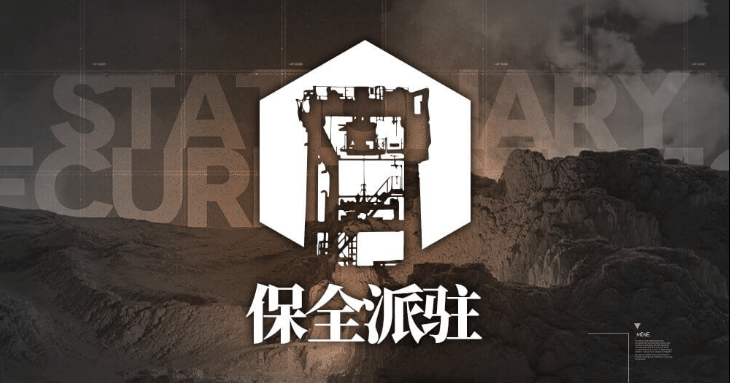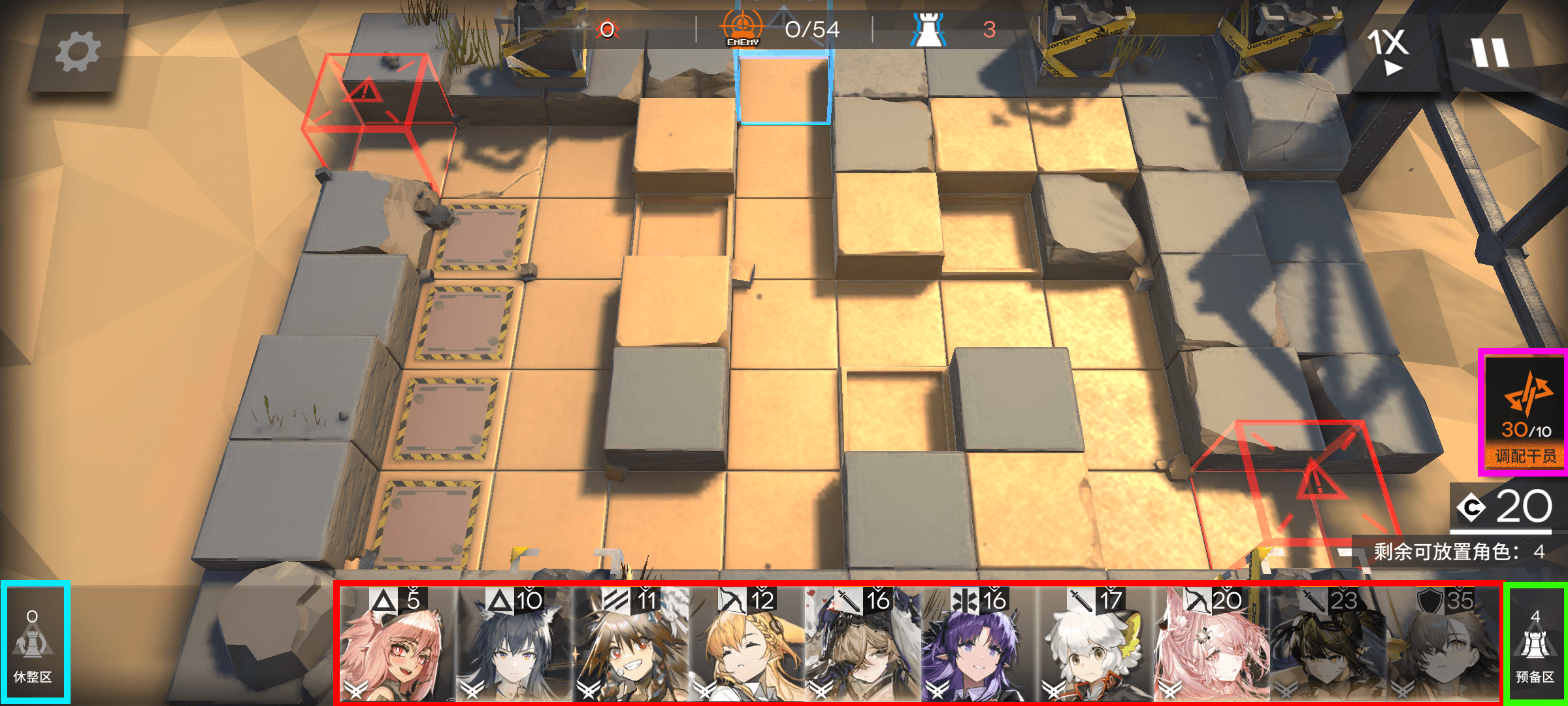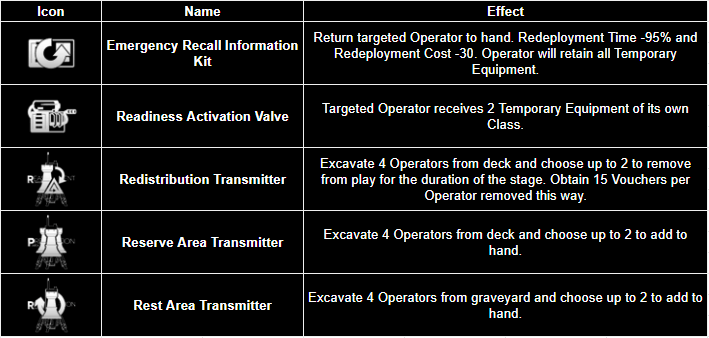Introduction
Stationary Security Service (or SSS for short) is a new gamemode introduced with the Lingering Echoes event that aims to modify the Arknights gameplay to somewhat resemble a card game. This gamemode is significantly more complex than anything we’ve had so far, and information on it can be somewhat obtuse to interpret. This article will aim to explain its major mechanics concisely so players know what to expect from the new gamemode.
This new gamemode will be unlocked after clearing the Main Story stage 1-5 and owning at least one Module.
Deck Mechanics
Drafting Operators for this mode works in a very different way to regular gameplay. To start the mode, players will be prompted to select 14 Operators from their roster (one of which can be a Support Operator if desired). These 14 Operators will constitute the player’s initial Team, which is the Deck equivalent for a card game and will be referred to as such for clarity through this article.
Players are also prompted to choose between two different Deployment Strategies, which will modify the possible Operators that will show up to be added to your Deck after each stage. These Strategies are the Preferred Strategy, which will try to pick Operators raised by the player more often, and the Free Strategy, which will pick among all Operators and even include Temporary Recruitments similar to Integrated Strategies.
After completing any of the 8 Stages present in a run of the mode, players will be given a choice between 4 Operators selected through the selected Deployment Strategy to add one of them to their Deck. This will happen twice after every Stage, giving players a somewhat randomized squad past their 14 initial choices.
At the start of a Stage, players will draw 10 Operators from their Deck into their To-be-deployed area (or their Hand, to be more understandable). Operators in the Hand can be deployed normally, as in regular gameplay. If desired, players can return up to 4 of these Operators to move to the Rest Area (or the Graveyard) in order to draw the same number of Operators from their Deck. This can be useful to get rid of very expensive Operators that you won’t be able to deploy until later on in the stage, or Operators that you won’t get much use out of at the moment. When there are no Operators in the Deck, all Operators in the Graveyard are immediately shuffled into it so you can draw more.
After this initial draw and mulligan, players may choose to draw from their Deck at any time using Vouchers, at the initial cost of 10 Vouchers per draw and increasing by 2 each time the Graveyard is shuffled into the Deck. 30 Vouchers are awarded at the start of each stage, and 1 more is obtained for each enemy killed. Reaching certain points of the stage which start a “Take a Break” section for a couple of seconds also awards 40 Vouchers instantly.
Operators retreating from the field (either from combat, manually or via the mechanics explained in the following point) will go directly into the Graveyard, so they cannot be drawn through these Vouchers until they are shuffled into the Deck, making it quite important to draw constantly.
Finally, the maximum Hand size is 12, and no more Operators can be drawn from the deck if the Hand is at its limit. This takes into account deployables such as Summons or Traps, so take this into account when recruiting Operators that can use these mechanics so you don’t run out of Hand space for more important Operators.
Relay Mechanics
One of the major gimmicks of this mode is the ability to place Operators on top of each other, which will move the first Operator to the Graveyard and grant the relay Operator a permanent buff based on their Class (Vanguard, Guard…). These buffs, called Temporary Equipment in-game, are extremely important as enemies become increasingly tough, and can be stacked multiple times for more layers of the same effect.
At the beginning of an SSS run, players will be prompted to choose between two Temporary Equipment effects for each Class individually, which will heavily define their strategy moving forward. These effects cannot be modified during a run, so make sure you pick the most appropriate for your objectives.
Additionally, Temporary Equipment Type B will not be available at the beginning, and requires clearing the mode at least once to unlock.
Each Operator can have a maximum of 5 Temporary Equipments in total. Further relays will not apply any new buffs and instead retain the first five that were applied.
Finally, Operators defeated in combat will not retreat automatically, but instead enter the Severely Wounded state for 20 seconds, during which they are unable to be targeted or perform any action. If a Severely Wounded Operator is not relayed or cured of the effect in time, they will be forcefully retreated and lose all Temporary Equipment, so it’s extremely important to deal with this effect rather quickly as it can signify a large loss of progress.
Conductive Units
At certain points during each stage, players may encounter special Elite enemies (Speedy-legged Thief, Weeping Detective and “Shiny Puff”) that do not deduct HP when entering the objective. If defeated, these enemies will drop a choice between three special Conductive Units, which will go directly to your Hand (or your Deck if there’s no space available) and be included in the Deck during subsequent Stages. These Conductive Units can be drawn like regular Operators but deployed only once per Stage, providing immediate effects that can be quite useful in battle.
Danger Level
Part of what makes SSS a hard (and tedious!) gamemode is the Danger Level mechanic, which progressively inflates enemy stats to the point where they can very easily have three times their regular HP.
Every 50 seconds, the Danger Level displayed to the left of the enemy counter will increase by 1, boosting the Attack and Defense of all enemies by 5%, and their Max HP by 25%. These boosts stack additively, making enemies in higher Danger Levels particularly tough.
Each stage starts at a different Danger Level, with the first being at 0 and the last at 7, and have different maximum levels for each part of the stage, going up to 20 during the second half of a run. Ideally players will want to avoid the Danger Level reaching such high numbers (at level 20 enemies have 100% more Attack and Defense and 500% more Max HP!), but the increases will be inevitable as enemies will take some time to spawn. Players must use the Temporary Equipment mechanic to boost their Operators to the point where they can still take care of these enemies.
Rewards
The rewards for this gamemode consist mainly of Data Supplement Strips and Data Supplement Devices. Barring the odd event store, this gamemode is the only real way to obtain these materials so far. These new materials will be used for the Module Upgrade system, unlocking a second and third stage with additional buffs for all Modules in the game.
These rewards reset twice a month, on the 1st and 16th, and consist of up to 30 Data Supplement Strips and 12 Devices, which is NOT ENOUGH to upgrade a 6★ Operator’s Module to either of the Stages, instead being slightly over half of what’s needed. As a result, Module Upgrades are heavily time-gated and always carry the opportunity cost of other, more impactful Module Upgrades. Make sure you’re certain on which ones you want to upgrade when the time comes.
There are also additional Strips, Devices and Module Blocks as rewards for first-time clears of every rotating site, and it is often more efficient to repeatedly clear the first few floors and avoid boss stages to obtain the full amount of rewards, which usually takes less time.
Good Operators
Operators that shine particularly well in this gamemode are those able to take full advantage of the buffs provided by the Temporary Equipment mechanic. While almost all Operators can benefit from these, a certain few rise above by having more powerful interactions than the rest.
A small sample of some of the most popular Operators for this gamemode include Goldenglow with 5 Sniper Type A boosts, which massively increases her damage output on her Skills through constant Drone explosions; Mudrock with 4 Vanguard Type A boosts that let her charge her second Skill fully every 3 seconds with a great Attack boost, and Irene with a mix of Vanguard Type A and Guard Type A boosts for constant usages of her third Skill with powerful Attack boosts to scale off of.
Future Updates
Due to the somewhat poor reception of the gamemode, Stationary Security Service will receive an update in the future (past the Il Siracusano event) which will double the rewards but lengthen the reward cycle itself to once a month, reduce the amount of stages from 8 to 6, and increase the initial Deck size from 14 to 20. This will make the mode significantly less grindy while still providing the same amount of materials for upgrades.



















